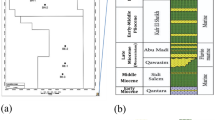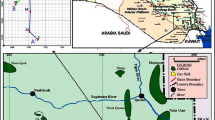Abstract
Comparing with conventional formations, the resistivity difference between the oil-bearing reservoir and water-saturated layer is little in the Triassic Chang 3 Member of the Yanchang Formation in Pengyang Region, southwestern Ordos Basin, China. This makes the oil-bearing potential reservoirs’ identification face a great challenge. To understand the genesis that makes the low-resistivity contrast in oil-bearing formations, several core samples are chosen to apply for routine physical property and X-ray diffraction analysis, nuclear magnetic resonance (NMR), and mercury injection capillary pressure (MICP) experimental measurements. Meanwhile, the formation water is also extracted from 19 wells to measure the total salinity and analyze the chemical components. The results illustrate that the Chang 3 Formation contains good pore structure and relative high porosity and permeability (the average porosity is 13.80%, and the average permeability is 6.81 mD). The effect of clay mineral to formation resistivity can be ignored. The main factors that cause low-resistivity contrast in oil-bearing layers are high formation water salinity and formation porosity. Combining the spontaneous potential (SP) with formation deep induction resistivity (RT), a parameter, named as the corrected resistivity index (CRI), is constructed, and the crossplots of reservoir porosity and CRI and flow zone index (FZI) versus CRI are raised to identify low-resistivity contrast oil-bearing layers in the northeastern and southwestern areas, separately. In addition, after normalizing porosity and CRI, the correlation coefficient between these two parameters is also calculated and used to indicate low-resistivity contrast oil-bearing potential layers. After these methods are extended to field applications, the oil-bearing potential formations in the Chang 3 Member are consecutively identified. The identification results match well with the drill stem test (DST) data, verifying the reliability of the proposed methods.
















Similar content being viewed by others
References
Akkurt R, Ahmad NA, Behair AM, Rabaa AS, Crary SF, and Thum S (2008) NMR radial saturation profiling for delineating oil-water contact in a high-resistivity low-contrast formation drilled with oil-based mud, paper Y presented at the SPWLA 49th Annual Logging Symposium, Austin, Texas, USA, May 25-28.
Amaefule JO, Altunbay M, Tiab D, Kersey DG, and Dare KK (1993) Enhanced reservoir description: using core and log data to identify hydraulic (flow) units and predict permeability in uncored intervals/well, paper SPE-26436 presented at the SPE Annual Technical Conference and Exhibition, Houston, Texas, USA, 3-6 October. DOI: https://doi.org/10.2118/26436-MS.
Ayadiuno CB, Khan S, AlAbbad AA, and AlMohsen F (2017) Investigating low resistivity-low contrast resistivity pay in a permo-carboniferous reservoir, central Saudi Arabia, paper SPE-188887 presented at the Abu Dhabi International Petroleum Exhibition & Conference, Abu Dhabi, UAE, 13-16 November. DOI: https://doi.org/10.2118/188887-MS.
Bastia RN, Tyagi AK, Saxena K, Klimentos T, Altman RM, Alderman S, and Bahuguna S (2007) Evaluation of low-resistivity-pay deepwater turbidites using constrained thin-bed petrophysical analysis, paper SPE-110752 presented at the SPE Annual Technical Conference and Exhibition, Anaheim, California, USA, 11-14 November. DOI: https://doi.org/10.2118/110752-MS.
Belevich A, Adriaan AB (2018) The problem with silt in low-resistivity low-contrast (LRLC) pay reservoirs. Petrophysics 59(2):118–135. https://doi.org/10.30632/PJV59N2-2018a1
Chatterjee R, Gupta SD, Farooqui MY (2012) Application of nuclear magnetic resonance logs for evaluating low-resistivity reservoirs: a case study from the Cambay basin, India. J Geophys Eng 9(5):595–610. https://doi.org/10.1088/1742-2132/9/5/595
Coates GR, Xiao LZ, Primmer MG (2000) NMR logging principles and applications. Gulf Publishing Company, Houston, pp 1–254
Connell JG, Morris RL, Tixier MP (1968) Log evaluation of low-resistivity pay sands in the Gulf Coast. Log Anal 9(6):0024–581X
Deng R, Guo HM, Xiao CW (2014) Apply array induction logging to study the low-resistivity belt zone identification method. Arab J Geosci 7:3409–3416. https://doi.org/10.1007/s12517-013-1049-4
Doll HG (1948) The SP log: theoretical analysis and principles of interpretation. Trans AIME 179(1):146–185. https://doi.org/10.2118/949146-G
Doll HG (1950) The SP log in shaly sands. J Pet Technol 2(7):205–214. https://doi.org/10.2118/950205-G
Dou WC, Liu LF, Wu KJ, Xu ZJ, Feng X (2017) Origin and significance of secondary porosity: a case study of upper Triassic tight sandstones of Yanchang Formation in Ordos Basin, China. J Pet Sci Eng 149:485–496. https://doi.org/10.1016/j.petrol.2016.10.057
Dunn KJ, Bergman DJ, Latorraca GA (2002) Nuclear magnetic resonance: Petrophysical and logging applications. Handbook of Geophysical Exploration, New York, pp 1–176
Gandhi A, Kubik P, Termina JJ, Rocque T, and Volkmar M (2011) Low resistivity petrophysical mapping expands the terry (Sussex) play in Wattenberg Field, Colorado, paper OO presented at the SPWLA 52nd Annual Logging Symposium, Colorado Springs, Colorado, USA, 14-18 May.
Givens WW (1987) A conductive rock matrix model (CRMM) for the analysis of low-contrast resistivity formations. Log Anal 28(2):138–151
Givens WW, and Schmidt EJ (1988) A generic electrical conduction model for low-contrast resistivity sandstones, paper E presented at the 29th SPWLA Annual Logging Symposium, San Antonio, Texas, USA, 5-8 June.
Guo S, Wang ZL, Zhang XL, Sun P (2012) Origin analysis on Chang 61 reservoir with low resistivity and its identification methods from Fanchuan Area, Zhidan Oil Field, in Northern Shaanxi, Ordos Basin. J Jilin Univ (Earth Sci Ed) 42(1):18–24
Hill HJ, Winsauer JD (1956) Effect of clay and water salinity on electro-chemical behaviour of reservoir rock. Trans AIME 207(1):65–72. https://doi.org/10.2118/532-G
Hodgkins MA, Howard JJ (1999) Application of NMR logging to reservoir characterization of low-resistivity sands in the Gulf of Mexico. AAPG Bull 83(1):114–127
Li HQ, Pu RH, Qu HJ, Zhao DY (2017) On identifying unconformity between Triassic and Jurassic in Ordos Basin by using logging data. J Northw Univ 47(4):577–584
Liu FT, Li RX, Zuo ZF, Liu XF, Zhao BS, Wu XL, Li DL (2018) Genesis of formation water in the 6th member of the Upper Triassic Yanchang Formation in southern Ordos Basin and its petroleum significance. Oil Gas Geol 39(6):1179–1189
Lqbal MA, Salim AMA, Baioumy H, Gaafar GR, Wahid A (2019) Identification and characterization of low resistivity low contrast zones in a clastic outcrop from Sarawak, Malaysia. J Appl Geophys 160(1):207–217. https://doi.org/10.1016/j.jappgeo.2018.11.013
Lucia FJ (1995) Rock-fabric/petrophysical classification of carbonate pore space for reservoir characterization. AAPG Bull 79(9):1273–1300
Mao ZQ (2001) The physical dependence and the correlation characteristics of density and neutron logs. Petrophysics 42(5):438–443
Mode AW, Anyiam OA, Aghara IK (2015) Identification and petrophysical evaluation of thinly bedded low-resistivity pay reservoir in the Niger Delta. Arab J Geosci 8:2217–2225. https://doi.org/10.1007/s12517-014-1348-4
Mogbolu PQ (2020) Identification and quantification of thinly bedded low resistivity pay in the Niger Delta. Paper SPE-141133 presented at the SPE Annual Technical Conference and Exhibition, Florence, Italy, 19-22 September. DOI: https://doi.org/10.2118/141133-STU.
Ouyang J, Mao ZQ, Xiu LJ, Shi YJ, Li CX (2009) Formation mechanism and evaluation method of low-concentration wells. Petroleum Industry Press, BeiJing, pp 1–153
Qiao JC, Zeng JH, Jiang S, Zhang YC, Feng S, Feng X, Hu HT (2021) Insights into the pore structure and implications for fluid flow capacity of tight gas sandstone: a case study in the upper paleozoic of the Ordos Basin. Mar Pet Geol 118:104439. https://doi.org/10.1016/j.marpetgeo.2020.104439
Ruiz JL, Gohary ME, Beshr HA, Hosani MA, Hannon L, and Rajwade S (2017) Low resistivity pay identification in Lower Cretaceous Carbonates, Onshore UAE, paper SPE-188804 presented at the Abu Dhabi International Petroleum Exhibition & Conference, Abu Dhabi, UAE, 13-16 November. DOI: https://doi.org/10.2118/188804-MS.
Sayed H, El Bakly O, Bello M, Saber A, and Villani L (2017) Field development and production optimization by identification of low resistivity low contrast (LRLC) pay zones for high heterogeneous sandstone reservoir in Bahariya Formation, Western Desert, Egypt, paper OMC-2017-571 presented at the Offshore Mediterranean Conference and Exhibition, Ravenna, Italy, 29-31 March.
Si Y, Niu XB, Liang XW, Shi LC, Zhu YS (2019) Main controlling factors of low resistivity and effective identification methods for the Chang 2 reservoir in the Jiyuan Area, Ordos Basin. Geol Explor 55(3):882–890
Sima LQ, Zhou JH, Zhang FS, Ren YX, Fang GQ (2013) Mud intrusion correction method for low resistance carbonate reservoir in Z oilfield in the Middle East. Spec Oil Gas Reserv 5:28–31
Singha D, Chatterjee R (2017) Rock physics modeling in sand reservoir through well log analysis, Krishna-Godavari basin, India. Geomechan Eng 13(1):99–117. https://doi.org/10.12989/gae.2017.13.1.099
Smits LJM (1968) SP log interpretation in shaly sands. Soc Pet Eng J 8(2):123–136. https://doi.org/10.2118/1863-B
Song F, Xiao CW, Bian ST, Su XJ, Wang HZ (2008) Origin of low resistivity reservoirs in low angle drape structure in Lunnan, Tarim Basin. Pet Explor Dev 35(1):108–112
Wang YC, Yang BX, Huang YZ (1981) Classification and evaluation of sandstone reservoir. Pet Geol Exp 4(293-298):324–331
Wang YJ, Song XM, He LP, Cheng NX, Yu HW (2010) Geologic origin of low-resistivity layers in deep reservoir of Gaoshangpu Oilfield. Acta Pet Sin 31(3):426–431
Wang WB, Guo DK, Chen XF, Ren RQ, Zhao J, Wang WB (2017) Genesis analysis and identification methods of Chang6 low resistivity oil pays in Yanchang Formation in Wuqi area, Ordos Basin. Petrol Geol Recov Effic 24(2):38–45
Waxman MH, Smits LJM (1968) Electrical conductivities in oil-bearing shaly sands. SPE Form Eval 8(2):107–122. https://doi.org/10.2118/1863-A
Waxman MH, Thomas EC (1974) Electrical conductivities in shaly sands: I. The relation between hydrocarbon saturation and resistivity index; II. The temperature coefficient of electrical conductivity. J Pet Technol 26(2):213–225. https://doi.org/10.2118/4094-PA
Waxman MH, Thomas EC (2007) Technical note: An addendum to electrical conductivities in shaly sands: I. The relation between hydrocarbon saturation and resistivity index; II. The temperature coefficient of electrical conductivity. SPE J 12(3):392. https://doi.org/10.2118/109632-PA
Wu Y, Zhang JG, Yin JT, Sun L (2019) The high resolution sequence stratigraphic framework and palaeo-geomorphologic restoration of Yanchang Formation in triassic system in Fuhuang exploration area of Ordos Basin. J Northw Univ 49(1):132–143
Xiao L, Mao ZQ, Wang ZN, Jin Y, Liu XG, Xie B (2012) Application of NMR logs in tight gas reservoirs for formation evaluation: a case study of Sichuan basin in China. J Pet Sci Eng 81:182–195. https://doi.org/10.1016/j.petrol.2011.12.025
Xiao L, Zou CC, Mao ZQ, Shi YJ, Li GR, and Guo HP (2013) The correlation analysis method and its application in hydrocarbon-bearing formation identification in tight sandstone reservoirs, paper SPE-166988 presented at the SPE Unconventional Resources Conference and Exhibition-Asia Pacific, Brisbane, Australia, 11-13 November. DOI: https://doi.org/10.2118/166988-MS.
Xiao L, Mao ZQ, Jin Y (2015) Tight gas sandstone reservoirs evaluation from nuclear magnetic resonance (NMR) logs: case studies. Arab J Sci Eng 40(4):1223–1237. https://doi.org/10.1007/s13369-015-1608-y
Xiao L, Li JR, Mao ZQ, Yu HY (2020) A method to evaluate pore structures of fractured tight sandstone reservoirs using borehole electrical image logging. AAPG Bull 104(1):205–226. https://doi.org/10.1306/04301917390
Zhai LH, Lin YB, Qin Z, Xiong T, Bao ZD, Gu YF, Yang SF, Shen JJ, Xie YR (2018) Genetic mechanism and identification methods of low resistivity oil reservoirs in Chang4+5 member of Yanchang Formation in Jiyuan area, Ordos Basin. Petrol Geol Recov Effic 25(2):50–57
Zhang HT, Duo XK, Yang XM, Zhou YL, Hu C, Li TT (2019) Genesis mechanism and fluid identification method of low-contrast oil layer in Jiyuan area. Well Log Technol 43(5):542–549
Zhu ZH, Lou ZH, Jin AM, Zhang RH, Si CS, Yao GS (2016) Hydrogeological-hydrogeochemical characteristics and hydrocarbon preservation conditions of the Qianbei Depression and its periphery, Upper Yangtze Block. Oil Gas Geol 37(6):862–873
Funding
This research was supported by the Major National Oil & Gas Specific Project of China (No. 2016ZX05050).
Author information
Authors and Affiliations
Corresponding author
Additional information
Responsible Editor: Santanu Banerjee
Rights and permissions
About this article
Cite this article
Li, G., Liu, D., Wang, Y. et al. Genesis analysis and identification of low-resistivity contrast oil-bearing reservoirs: a case study in the Triassic Chang 3 Member of the Yanchang Formation in Pengyang Region, Southwestern Ordos Basin, China. Arab J Geosci 14, 1649 (2021). https://doi.org/10.1007/s12517-021-08052-9
Received:
Accepted:
Published:
DOI: https://doi.org/10.1007/s12517-021-08052-9




